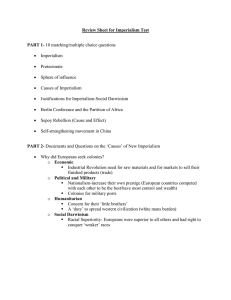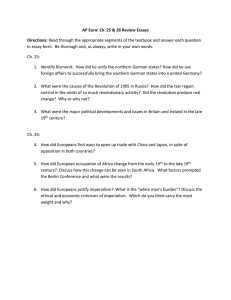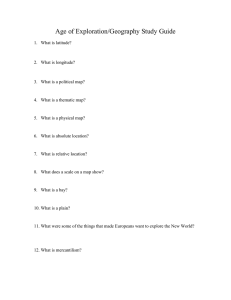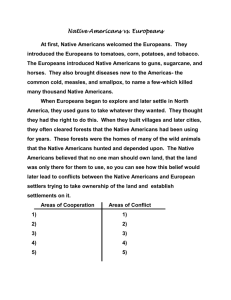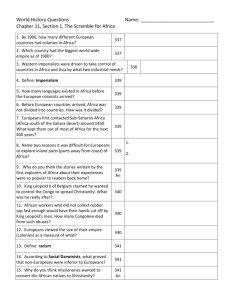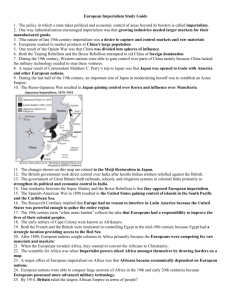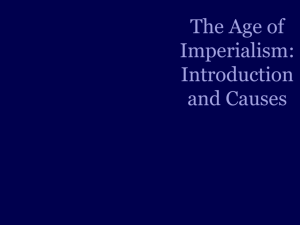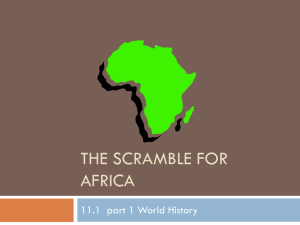West and the World - Glasgow Independent Schools
advertisement
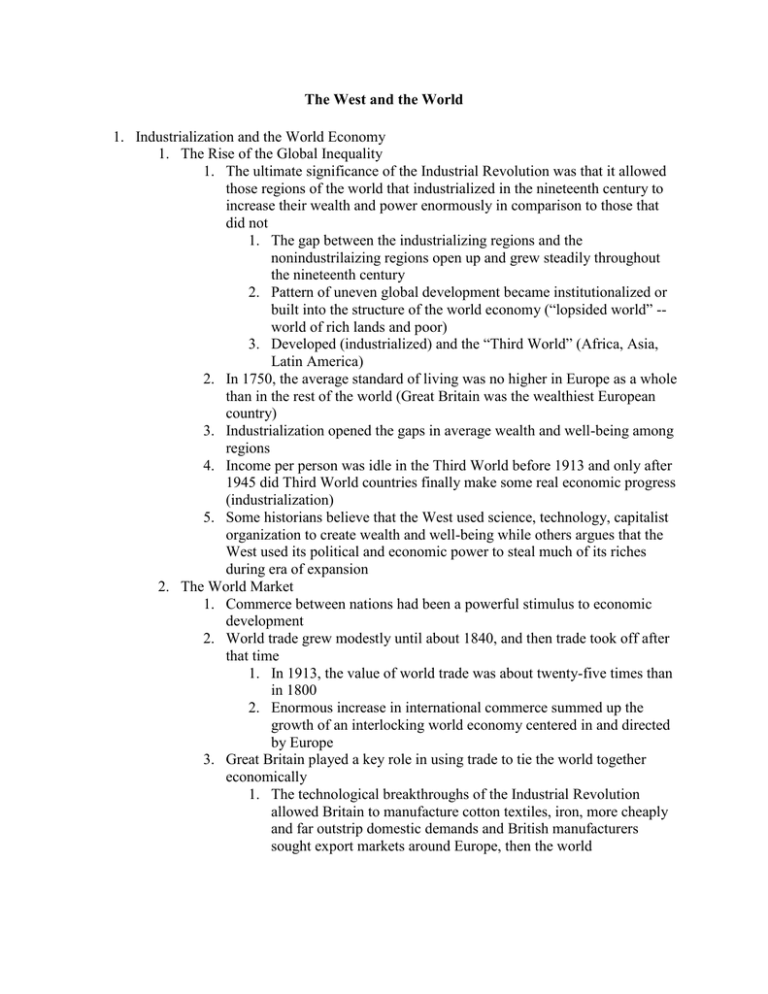
The West and the World 1. Industrialization and the World Economy 1. The Rise of the Global Inequality 1. The ultimate significance of the Industrial Revolution was that it allowed those regions of the world that industrialized in the nineteenth century to increase their wealth and power enormously in comparison to those that did not 1. The gap between the industrializing regions and the nonindustrilaizing regions open up and grew steadily throughout the nineteenth century 2. Pattern of uneven global development became institutionalized or built into the structure of the world economy (“lopsided world” -world of rich lands and poor) 3. Developed (industrialized) and the “Third World” (Africa, Asia, Latin America) 2. In 1750, the average standard of living was no higher in Europe as a whole than in the rest of the world (Great Britain was the wealthiest European country) 3. Industrialization opened the gaps in average wealth and well-being among regions 4. Income per person was idle in the Third World before 1913 and only after 1945 did Third World countries finally make some real economic progress (industrialization) 5. Some historians believe that the West used science, technology, capitalist organization to create wealth and well-being while others argues that the West used its political and economic power to steal much of its riches during era of expansion 2. The World Market 1. Commerce between nations had been a powerful stimulus to economic development 2. World trade grew modestly until about 1840, and then trade took off after that time 1. In 1913, the value of world trade was about twenty-five times than in 1800 2. Enormous increase in international commerce summed up the growth of an interlocking world economy centered in and directed by Europe 3. Great Britain played a key role in using trade to tie the world together economically 1. The technological breakthroughs of the Industrial Revolution allowed Britain to manufacture cotton textiles, iron, more cheaply and far outstrip domestic demands and British manufacturers sought export markets around Europe, then the world 2. After the repeal of the Corn Laws in 1846, Britain became the world’s single best market and until 1914 remained the world’s “emporium” (free access) 4. The growth of trade was facilitated by the conquest of distance 1. The earliest railroad construction occurred in Europe and in America north of the Rio Grande and wherever railroads were built, they reduced transportation costs, opened new economic opportunities and called forth new skills and attitudes 2. The power of steam revolutionized transportation by sea as well as land 3. Steampower began to supplant sails on the oceans of the world in the late 1860s 4. Passenger and freight rates tumbled and the intercontinental shipment of lower-priced raw materials became feasible (development of 19th century global trade) 5. The revolution in land and sea transportation helped European pioneers open up vast new territories and produce agricultural products and raw materials for sale in Europe 6. Intercontinental trade was enormously facilitated by the Suez and Panama canals; investment in modern port facilities made lading and unloading cheaper and more dependable; transoceanic telegraph cables inaugurated rapid communications 7. The growth of trade and the conquest of distance encouraged the expanding European economy to make massive foreign investments (Great Britain, France, and Germany) 8. Most of the capital exported did not go the European colonies or protectorates in Asia and Africa but rather to other European countries (construction of utilities for settling) 9. Europeans collected interest and opened up trade but victims were native American Indians and Australian aborigines who were decimated by expanding Western society 3. The Opening of China and Japan 1. With densely populated civilizations, Europeans increased their trade and profit 2. The expanding Western society was prepared to use force, if necessary, to attain its desires in China and Japan (examples of general pattern of intrusion) 3. Traditional Chinese civilization was self-sufficient and China had sent more goods and inventions to Europe than it had received in the eighteenth century (Chinese tea) 1. Trade with Europe was carefully regulated by the Chinese imperial government (Manchu Dynasty) which was more interested in isolating and controlling the strange “sea barbarians” than in pursuing commercial exchange 2. The imperial government refused to establish diplomatic relations with Europe and required all foreign merchants to live in the southern city of Canton 3. Practices considered harmful to Chinese interests, such as the sale of opium and the export of silver from China, were strictly forbidden 4. By the 1820s, the dominant group, the British, introduced the smoking of opium 1. Grown legally in India, opium was smuggled into China by means of fast ships and bribed officials and as the British merchants became greedier, the more they resented the patriotic attempts of the Chinese government to stem drug addiction 2. By 1836, the aggressive goal of the British merchants in Canton was an independent British colony in China and “safe and unrestricted liberty” in trade 3. They pressured the British government to take decisive action and at the same time, the Manchu government decided that the opium trade had to be stopped 4. The government began to prosecute Chinese drug deals and in 1839, send special envoy Lin Tse-hsu to Canton who ordered the merchants to obey China’s laws 5. Using troops from India and controlling the seas, the British occupied several coastal cities and forced China to surrender after declaring war; in the Treaty of Nanking in 1842, the imperial government was forced to cede the island of Hong Kong, pay an indemnity of 100 million dollars and open up four cities to foreign trade (low tariffs) 6. The opium trade and Hong Kong developed rapidly as an Anglo-Chinese commune 7. The Chinese, however, refused to accept foreign diplomats in Peking, the imperial capital, and there was a second round of foreign attack between 1856 and 1860, culminating in the occupation of Peking by British and French troops; another round of harsh treaties gave European merchants and missionaries privileges and protection 8. The government of Japan decided to seal off the country from all European influences in order to preserve traditional Japanese culture and society (after 1640) 9. Japan’s unbending isolation seemed hostile to the West, particularly to the U.S. 1. The isolation complicated the practical problems of shipwrecked American sailors and the provisioning of whaling ships and China traders sailing in the Pacific 2. Americans shared self-confidence and dynamism of expanding Western society 10. After unsuccessful attempts to establish commercial relations with Japan Commodore Matthew Perry steamed into Edo Bay in 1853 demanding diplomatic negotiations 11. Senior officials realized how defenseless cities were against naval bombardment and they reluctantly signed a treaty with the U.S. that opened two ports permitting trade 4. Western Penetration of Egypt 1. European involvement in Egypt led to a new model of formal political control 2. Egypt had been ruled by the Ottoman Turks and then after the occupation of the French armies for three years stepped in Turkish general, Muhammad Ali 1. First appointed governor of Egypt by the Turkish sultan, Ali set out to build his own state on the strength of a large, powerful army organized along European lines; he drafted the illiterate and hired army European army officers to train 2. By the time of his death in 1849, Muhammad Ali had established a strong and virtually independent Egyptian state to be ruled by his family on hereditary basis 3. Ali’s policies of modernization attracted large numbers of Europeans to Egypt 4. Europeans served as army officers, engineers, doctors, high government officials, and police officers; other found prosperity in trade, finance, and shipping 3. To pay for a modern army and European services and manufactured goods, Muhammad Ali encouraged the development of commercial agriculture geared to the European market (new landlords made the peasants their tenants and forced them to grow cash crops for European markets and modernized agriculture in Egypt) 4. Muhammad Ali’s grandson Ismail, (in 1863 began rule as Egypt’s khedive, or prince) was a westernizing autocrat, promoting large irrigation networks (cotton production) 5. Ismail borrowed large sums to install modern communications; Suez Canal completed by a French company in 1869 and Arabic of the masses became the official language 6. Egyptians educated in Europe helped spread new skills and ideas in the bureaucracy 7. Ismail’s projects were too expensive and by 1876, Egypt owned foreign bondholders 450 million dollars but the governments of France and Great Britain intervened politically to protect the European bankers who held the Egyptian bonds; they forced Ismail to appoint French and British commissioners to oversee Egyptian finances 8. Foreign financial control evoked a nationalistic reaction among Egyptian religious leaders and in 1879, under Colonel Ahmed Arabi, they formed the Egyptian Nationalist party and forced Ismail to abdicate in favor of his weak son Tewfiq 9. All this resulted in bloody anti-European riots in Alexandria in 1882 and a number of Europeans were killed and Tewfiq and his court had to flee to British ships for safety 10. Riots swept the country but a British expeditionary force decimated Arabi’s forces and as a result, occupied all of Egypt; the British maintained the façade of the khedive’s government as an autonomous province of the Ottoman empire and the British consul, General Evelyn Baring (Lord Cromer) ruled the country after 1883 11. Egypt shoed such expansion was based on military force, political domination, and a self-justifying ideology of beneficial reform (predominate until 1814) 2. The Great Migration 1. The Pressure of Population 1. In the early 18th century, the growth of European population entered a decisive stage; birthrates eventually declined in the nineteenth century but so did death rates because of rising standard of living and medical revolution (population doubled in Europe) 2. Between 1815 and 1932, more than sixty million people left Europe and the population of North America grew from six million to eighty-one million from 1800-1900; population grew more slowly in Africa and Asia (Europeans 38 % of world) 3. The growing number of Europeans provided the drive for expansion and emigration 1. In most countries migration increased twenty years after a rapid growth in population and this pattern was prevalent when rapid population increase predated extensive industrial development (hope of creating jobs and reducing poverty) 2. The number of people who left Europe increased rapidly before World War One 3. Different countries had very different patterns of movement; people left Britain and Ireland in large numbers, German migration was irregular, and Italians left 4. Migration patterns mirrored social and economic conditions in the country 5. Although the United States absorbed the largest number of European migrants, less than half of all migrants went to the United States 2. European Migrants 1. The European migrant was often a small peasant landowner or craftsman whose traditional way of life was threatened by too little land, estate agriculture, or factories 1. German peasants who left southwestern Germany between 183054 felt trapped by the “dwarf economy” with its tiny landholdings and declining craft industries 2. Many sold out and moved to buy much cheaper land in the American Midwest 2. Migrants were a great asset to the countries that received them (vast and unmarried); they came ready to work hard in the new land, at least for some time 3. Many Europeans moved but remained within Europe, setting temporarily or permanently in another European country (vast bulk of this movement was legal) 4. Many Europeans were truly migrants as opposed to immigrants (returned after some time) and the likelihood or repatriation varied greatly by nationality 5. The possibility of buying land in the old country was of central importance 6. The Russia Jews were left in peace until 1881 when a new tsar brought discrimination 1. Russia’s five million Jews were confined to the market towns and small cities of the so-called Pale of Settlement where they worked as artisans and petty traders 2. When Russian Jewish artisans began to escape both factory competition and oppression by migrating in the 1880s, this was a once-and-for-all departure 7. The mass movement of Italians illustrates many characteristics of European migration 1. In the 1880s, three in every four Italians depended on agriculture and with the influx of cheap North American wheat, industry was not advancing fast enough to provide jobs for the rapidly growing population and Italians began to leave 2. Migration provided Italians with an escape valve and possible income to buy land 3. Many Italians went to the United States, but more went to Argentina and Brazil 4. Many Italians had no intention of setting abroad permanently (“swallows”) and harvesting Italy, flew to Argentina to harvest wheat during the winter months and returned to Italy in the spring and repeated this exhausting process 5. Italian migrants dominated building trades and architectural profession in L.A. 8. Other Italians migrated to other European countries and many went to France 1. Ties of family and friendship played a crucial role in the movements of peoples 2. Many landless Europeans left because of the spirit of revolt and independence (young people frustrated by privileged classes in Norway and Sweden) 9. Migration slowed down when the people won basic political and social reforms such as the right to vote and the social security system 3. Asian Migrants 1. A substantial number of Chinese, Japanese, Indians, and Filipinos responded to rural hardship with temporary or permanent migration (three million moved before 1920) 2. Most went as indentured laborers to work under incredibly difficult conditions and white estate owners often used Asians after the suppression of the slave trade 3. In the 1840s, the Spanish government recruited Chinese laborers in Cuba and they came under eight-year contracts, where paid and fed but between 1853 and 1873, more than 130,000 Chinese laborers went to Cuba and spent their lives as slaves 4. Asians fled the plantations and gold mines as soon as possible, seeking greater oppor-tunities in trade and towns and came into conflict with setters in settlement areas 5. These settlers demanded a halt to Asian migration and by the 1880s, Americans and Australians were building discriminatory laws designed to keep Asians out 6. A final, crucial factor in the migrations before 1914 was the general policy of “whites only” in the open lands of possible permanent settlement (part of Western dominance) 3. Western Imperialism 1. The Scramble for Africa 1. As late as 1880, European nations controlled only 10 percent of the African continent 1. The French had begun conquering Algeria in 1830 and European colonists settled 2. In South Africa, the British had taken possession of Dutch settlements at Cape Town during the wars of Napoleon I and had led Dutch ranchers and farmers in 1835 to make the Great Trek into the interior, where they fought natives for land 3. After 1853, the Boers (Afrikaners, descendents of the Dutch in the Cape Colony) proclaimed their political independence and defended it against British armies 4. By 1880 Afrikaner and British settlers taken control from the Zulu and Xhosa 5. The British conquered in southern Africa in the bloody Boer War (1899-1902) 2. European trading posts and forts dating back to the Age of Discovery and the slave trade dotted the coast of West Africa (Portuguese held some old possessions) 3. From 1880-1900, Britain, France, Germany, and Italy fought for African possessions and by 1900 nearly the whole continent had been split & placed under European rule; only Ethiopia in northeast Africa and Liberia in West Africa remained independent 4. There was the role of Leopold II of Belgium, a monarch with lust for distant territory 1. By 1876, Leopold was focusing on central Africa and formed a financial syndicate under his personal control to send Henry M. Stanley to the Congo basin 5. 6. 7. 8. 2. Stanley was able to establish trading stations, sign “treaties” with African chiefs, and plant Leopold’s flag (France send out an expedition under Pierre de Brazza) 3. In 1880 de Brazza signed a treaty of protection with the chief of a large Teke tribe and began to establish a French protectorate on the north bank of the Congo river Leopold’s buccaneering intrusion into the Congo area raised the question of the political fate of black Africa—Africa south of the Sahara; when the British successfully invaded Egypt in 1882, Europe had caught “African fever” Jules Ferry of France and Otto von Bismarck of Germany arranged an international conference on Africa in Berlin in 1884 and 1885 and established the principle that European claims to African territory had to rest on “effective occupation” 1. It meant that Europeans would push relentlessly into interior regions from all sides and that no European power would be able to claim the entire continent 2. The conference recognized Leopold’s personal rule over a neutral Congo free state and declared all of Congo basin a free trade zone (wanted to stop slavery) 3. The Berlin conference coincided with Germany’s sudden emergence as an imperial power; Bismarck has seen little value in colonies before 1880 4. In 1884 and 1885, Bismarck and Germany established protectorates over a number of African kingdoms and tribes in Togo, Cameroon, southwest Africa, and, later, East Africa (cooperated against the British with France’s Ferry) 5. The French pressed southward from Algeria eastward from the Senegal coast, and northward from the Congo River (object of these three thrusts was Lake Chad) The British began enlarging their West African enclaves and pushed northward from the Cape Colony and westward from Zanzibar (thrust southward from Egypt was blocked in the Sudan by independent Muslims who won at Khartoum in 1885) In 1895 another British force, under General Horatio Kitchener moved up the Nile River building a railroad to supply arms and reinforcements as it went 1. Finally in 1898, the British troops met the Muslim tribesmen, armed with spears, at Omdurman but were massacred by the recently invented machine gun 2. Continuing up the Nile after the Battle of Omdurman, Kitchener’s armies found a French force in the village of Fashoda (France had tried to beat the British to one of Africa’s last unclaimed areas— the upper reaches of the Nile 3. The result was a serious diplomatic crisis and even the threat of war 4. Wracked by the Dreyfus affair, France backed down and withdrew its forces 2. Imperialism in Asia 1. In 1815, the Dutch ruled the island of Java in the East Indies and brought almost all of the archipelago under their political authority (shared with Britain and Germany) 2. In the 1880s, the French under the leadership of Ferry took Indochina 3. Two other great imperialist powers, Russia and the United States, also acquired rich territories in Asia; Russia had been marked by almost continual expansion continued to move south of the Caucasus and in central Asia and nibbled at Far East in 1890s 4. The United States’ great conquest was the Philippines, taken from Spain in 1898 after the Spanish-American War and when it became clear independence was not going to be granted, Philippine patriots rose in revolt and were suppressed after bitter fighting 3. Causes of the New Imperialism 1. Economic motives played an important role in the extension of political empires, especially the British Empire; by the 1870s, France, German, and the United States were industrializing rapidly behind rising tariff barriers 1. Great Britain was losing its lead and facing competition in foreign markets, Britain came to value old possessions, such as India and Canada, more highly 2. When continental powers began to grab all unclaimed territory in the 1880s, the British followed suit and feared that France and German would seal off empires with high tariffs and restrictions and that economic opportunities would be lost 2. The overall economic gains of the new imperialism proved quite limited before 1914 1. The new colonies were just too poor to buy much and offered few investments 2. Colonies became important for political and diplomatic reasons and countries saw colonies as crucial to national security, military power, and international prestige 3. National security was a factor in a U.S. decision to establish Panama Canal Zone 3. Many people were convinced that colonies were essential to great nations and Treitschke’s belief reflected aggressiveness of European nationalism 4. Social Darwinism and harsh racial doctrines fostered imperialist expansion as well as the industrial world’s unprecedented technological and military superiority 1. The rapidly firing machine gun was the ultimate weapon in any unequal battle 2. The newly discovered quinine proved effective in controlling attacks of malaria 3. The combination of the steamship and the international telegraph permitted Western powers to quickly concentrate their firepower in a given area 5. Social tensions and domestic political conflicts contributed to overseas expansion 1. Conservative political leaders were charged with manipulating colonial issues in order to divert popular attention from the class struggle at home (national unity) 2. Government leaders and their allies in the press successfully encouraged the masses to savor foreign triumphs and glory in the supposed increase in prestige 6. Certain special-interest groups in each country were powerful agents of expansion 1. Shipping companies wanted lucrative subsidies and white settlers on dangerous frontiers constantly demanded more land and greater protection 2. Missionaries and humanitarians wanted to spread religion but stop the slave trade; explorers and adventurers sought knowledge and excitement 3. Military men and colonial officials saw rapid advancement and high-pay positions in growing empires (actions of such groups thrust course of empire forward 7. Imperialists developed arguments in order to satisfy their consciences and their critics 1. Europeans could and should “civilize” more primitive, nonwhite peoples 2. Many Americans accepted the ideology of the white man’s burden and was an important factor in the decision to rule, rather than liberate, the Philippines 3. Peace and stability under European control permitted the spread of Christianity—the true religion and Europeans competed with Islam in seeking converts 4. Such successes in black Africa contrasted with general failure of missionary effort in India, China, and the Islamic world (Christian believers did not increase) 4. Critics of Imperialism 1. The expansion of empire aroused critics and a forceful attack was delivered in 1902, after the unpopular Boer War, by English economic Hobson in his Imperialism 1. Hobson contended that the rust to acquire colonies was due to the economic needs of unregulated capitalism (the need of the rich to find outlets for surplus capital) 2. Yet, he argued, imperial possessions did not pay off economically for the country and only special-interest groups profited from them, at the expense of people 3. Most people were sold on the idea that imperialism was economically profitable for the homeland, and a general enthusiasm for the empire developed 2. Similarly in Heart of Darkness, novelist Joseph Conrad castigated the “pure selfishness” of Europeans in “civilizing” Africa 3. Critics charged Europeans with applying a degrading double standard and failing to live up to their own noble ideals (Europeans imposed military dictatorships on Africans and Asians, forced them to work like slaves, and discriminated (liberation) 4. Reponses to Western Imperialism 1. Introduction 1. The initial response of African and Asian rulers was to try drive the foreigners away but beaten in battle, many concentrated on preserving their cultural traditions 2. Political participation in non-Western lands was usually limited to small elites and the Europeans received considerable support from both traditionalists (local chiefs, landowners, religious leaders and modernizers (Western-education professionals) 3. The nonconformists—the eventual anti-imperialist leaders-developed a burning desire for human dignity and came to feel such dignity was incompatible with foreign rule 4. Potential leaders found in the West the ideologies and justification for their protest 5. Nonconformists found themselves attracted to modern nationalism, which asserted that every people had the right to control its own destiny (India, Japan, and China) 2. Empire in India 1. India was ruled more or less absolutely by Britain for a very long time 1. Arriving in India, the British East India Company had conquered the last independent native state by 1848 and the last “traditional” response to European rule (military force by ruling classes) was broken in India in 1857 and 1858 2. During the Great Rebellion, the insurrection by Muslim and Hindu mercenaries in the British army spread throughout northern and central India before it was crushed by loyal native troops from southern India (European domination) 2. After 1858 India was ruled by the British Parliament in London and administered by a tiny, all-white civil service in India (white elite, backed by white officers and native troops, was competent and well disposed toward the welfare of the peasant masses 3. Most of the members considered the Indian people and castes to be racially inferior 4. The British Parliament in 1883 was considering a major bill to allow Indian judges to try white Europeans in India, the British community rose in protest and defeated it 5. The British established a modern system of progressive secondary education in which all instruction was in English (offered some Indians opportunities for advancement) 6. The new bureaucratic elite played a crucial role in modern economic development 1. Irrigation projects for agriculture, the world’s third largest railroad network for good communications, and large tea and jute plantations were developed 2. With a well-educated, English-speaking Indian bureaucracy and modern communications, the British created a unified, powerful state 3. The British placed under the same general system of law and administration the different Hindu and Muslim people and the vanquished kingdoms of the continent 7. The decisive reaction to European rule was the rise of nationalism among the elite; the top jobs, the best clubs, the modern hotels were sealed off the Indian people 8. By 1885 when educated Indians came together to found the predominately Hindu Indian National Congress, demands were increasing for the equality and self-government; reform of the Hindu religion called for national independence 3. The Example of Japan 1. When Commodore Perry arrived at Japan (1853), Japan was a complex feudal society 1. At the top stood a figurehead emperor but real power had been in the hands of a hereditary military governor, the shogun and with the help of a warrior-nobility known as samurai, the shogun governed a country of hard-working people 2. The intensely proud samurai were humiliated by the sudden American intrusion 2. When foreign diplomats and merchants began to settle in Yokohama, radical samurai reacted with a wave of anti-foreign terrorism and antigovernment assassinations between 1858 and 1863; the imperialist response was swift and unambiguous 3. An allied fleet of American, British, Dutch and French warships demolished key forts, and further weakening the power and prestige of the shogun’s government 4. In 1867, a coalition led by patriotic samurai seized control of the government and restored the political power of the emperor (Meiji Restoration) 1. The most important goal of the new government was to meet the foreign threat 2. The young but well-trained, idealistic but flexible leaders of Meiji Japan dropped their anti-foreign attacks and were convinced that Western civilization was indeed superior in its military and industrial aspects (reform along modern lines) 5. In 1871, the new leaders abolished the old feudal structure of aristocratic, decentralized government and formed a strong unified state; they dismantled the four-class legal system and declared social equality (freedom of movement granted) 6. The overriding concern of Japan’s political leadership was always a powerful state 1. A powerful modern navy was created and the army was completely reorganized, with three-year military service for all males and a professional officer corps 2. Japan also borrowed rapidly and adapted skillfully the West’s science and modern technology, particularly in industry, medicine, and education 7. By 1890, Japan established an authoritarian constitution and rejected democracy and Japan successfully copied the imperialism of Western society (expansion) 1. Japan opened Korea with gunboat diplomacy of imperialism in 1876, defeated China in a war over Korea in 1895 and took Formosa (current-day Taiwan) 2. In 1904, Japan attacked Russia without warning and Japan emerged victorious 8. Japan became the first non-Western country to use the ancient love of country to transform itself and thereby meet the many-sided challenge of Western expansion; Japan provide as an example of national recovery and liberation 4. Toward Revolution in China 1. In 1860, the Manchu Dynasty in China appeared on the verge of collapse; efforts to repel foreigners had failed, and rebellion and chaos wracked the country 2. The government drew on its traditional strengths and made a surprising comeback 1. Traditional ruling groups temporarily produced new and effective leadership; loyal scholar-statesmen and generals quelled disturbances such as the great Tai Ping rebellion and empress dowager Tzu Hsi revitalized the bureaucracy 2. Destructive foreign aggression lessened for the Europeans had obtained their primary goal of commercial and diplomatic relations 3. Europeans reorganized China’s customs office and increased tax receipts, others represented China in foreign lands and helped strengthen central government 3. The parallel movement toward domestic reform and limited cooperation with the West collapsed under the blows of Japanese imperialism 4. The Sino-Japanese war of 1894 to 1895 and the subsequent harsh peace treaty revealed China’s helplessness in the face of aggression, triggering a rush for foreign concessions and protectorates in China (jealously saved China from partition 5. The U.S. Open Door policy, which opposed formal annexation of Chinese territory may have helped tip balance (impact of foreign penetration accelerated after 1894) 6. Like the leaders of the Meiji Restoration, some modernizers saw salvation in Western institutions and in 1898, the government launched a desperate “hundred days of reform” in an attempt to meet the foreign challenge; many radical reforms came from the peasantry and sought to overthrow the dynasty altogether and establish a republic 7. Some traditionalists turned back toward ancient practices, political conservatism and fanatical hatred of the “foreign devils” (clashed with foreign missionaries) 8. In the agony of defeat and unwanted reforms, secret societies such as the Boxers rebelled and many foreigners were killed in northeastern China 9. Again response was swift and Peking was occupied by foreign armies (indemnity) 10. The years after the Boxer Rebellion (1900-1903) were more troubled and finally in 1912, a spontaneous uprising toppled the Manchu Dynasty; loose coalition of revolutionaries proclaimed a West-style republic and called for an elected parliament
